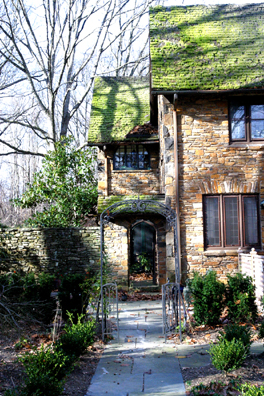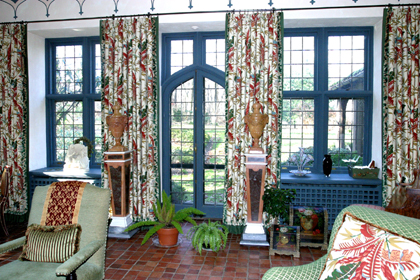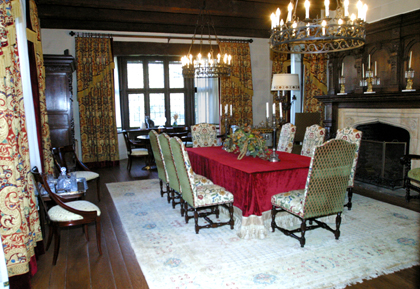
| NEWS |
| |
| FEATURES |
| ENTERTAINMENT |
| COLUMNS |
| CONTACT US |
| HOW TO SUBMIT |
| BACK ISSUES |

caption:
End of caption |
Historical Society Holiday House Tour Will Feature Six Unique Princeton Houses
A new holiday tradition has become part of this festive season. For the second year, the Historical Society of Princeton will hold its Holiday House tour, when six private homes will be open to the public on Saturday, December 6, from 10 a.m. to 4 p.m.
"This is the second consecutive year we have had the tour, although we have had them sporadically since the 1970s," says Donna Evans, director of development of the Historical Society. "We are reinforcing the tradition, and it helps to support the Society's education program. The goal is to show as much of Princeton's history as possible. Last year, we had 400 visitors, and we hope to equal that."
The houses represent different eras and architectural styles and are furnished today to reflect the taste of their residents, she explains.
Two early 19th century houses, including one designed by Princeton architect/builder Charles Steadman before 1830, are featured, along with two houses built later in the 19th century, one a Gothic Victorian, and the other representative of the development of Princeton's "tree" streets.
Two 20th century houses are included: "Rothers Barrows", an Arts & Crafts style house built in the early part of the century, and a mid-20th century house constructed with the 21st century in mind. Each house on the tour has its own history to tell.
Selection of the houses is the result of a combination of occurrences," explains Ms. Evans. "We have a committee that makes recommendations, and I must say I have been overwhelmed by how generous people have been regarding their houses."
Unique History "The goal is to give visitors a glimpse of Princeton's past architecturally, socially, and economically," adds event chair Carol Wojciechowicz. "Each house has its own unique history."
While, indeed, every house has its own history, each reflects the sensitivity of its current owners to the house's past, and at the same time fulfills its function as a residence suitable for contemporary living.
"Some people go to see the houses with the intention of decorating their own homes, and they're looking for ideas," notes Ms. Evans. "Others are interested in the houses' historical significance. It's up to the homeowner to decide which rooms are accessible. Most often, it's the downstairs rooms."
A limited number of tickets are available by advance sale only, to include tea at Princeton University's Prospect House between 1 and 4, she adds. Built about 1850 by Scottish-born architect John Notman, the Italianate stone villa served as the home of Princeton's presidents from 1878 until 1968. Woodrow Wilson is the best known of the six presidents who lived there, and the house was named a National Historic Landmark in his honor. In 1968, Prospect House was renovated as the University's faculty and staff social facility.
caption:
|
Rothers Barrows
Among the houses on the tour is "Rothers Barrows", an extraordinarily elegant stone house on Arreton Road. One of Princeton's best examples of Arts & Crafts style architecture, it was planned as part of a 117-acre equestrian estate by the prominent Philadelphia architect Wilson Eyre. Only 1/3 of the house was finished when construction stopped in 1919.
The original owners, Donald "Heff" Herring and his wife Jesse Markham Herring, moved into the house after World War I. Mr. Herring was Princeton's first Rhodes Scholar, a member of the University's faculty, and editor of the "Princeton Alumni Weekly." The Herrings kept the property until 1939, although the Depression had prevented them from completing the house. In later years, a den, sun room, and portico were added, but the structure is essentially the same as it was in 1919.
Architect Eyre designed the grounds in the "Chestnut Hill" style, characterized by native trees, underplanted with azaleas and rhododendrons. Beyond the elegant stone-walled sunken terrace was a croquet lawn. A show ring was built to the west of the barn complex, along with a 960-yard race track.
Over time, the property was developed, and Arreton Road was laid out, changing the approach to the house. The current owners Scott and Jeri Schaefer, who have lived in Rothers Barrows for three years, have thoughtfully and carefully undertaken changes to the house. For example, they commissioned Mercer Tile Works in Doylestown, Pa. to create tiles for rooms they are renovating, knowing that Wilson Eyre worked closely with the company's founder, Henry Mercer, on many projects, including the terra cotta tile floor in the living room.
"We have done a lot of work," explains Mrs. Schaefer. "We like the look of the house, and we wanted to keep it in the original style, but modernizing it to today's needs. " The opportunity to live in Rothers Barrows was a dream come true, she reports.
Manor Houses
"My husband and I have traveled a lot in Europe, especially in England, and we've always loved our friends' old manor houses. We thought 'wouldn't it be lovely to live in one?' but we felt we'd never find one here. Then, simultaneously, we both saw it listed in the paper, and we said it sounds like something we're looking for.
"I walked in and said, 'if we could live here, it's what we have always wanted.' Also, I always wanted land, and now we have four and a half acres."
The house is a blend of Arts & Craft style and English country manor, she adds. "When it was built in 1919, the Arts & Crafts style was particularly popular. We haven't discovered the origin of the name Rothers Barrows, which remains a mystery, however."
While the house is grand in size and scope, with seven bedrooms, five fireplaces, swimming pool and tennis court, it is warm and welcoming.
"I feel the house is a gracious, warm, and very inviting home," points out Mrs. Schaefer. "It's not ostentatious. It's a real, lived-in house, with two children, two dogs, and a cat that run through it!
"Since the house is very, very large, we are taking a lot of time and care in redecorating. We have refinished all the floors, and the electrical and air conditioning systems have been redone. I've changed the configuration of the kitchen because we need more space, and we spend a lot of time in it. But we redesigned it with deference to the original style and our own life-style today. We are definitely still a work in progress, but we have been working with a phenomenal decorator and designer – the firm of Marshall Watson Interiors and the late wonderful designer, Holmes Easley.
caption:
|
Exposed Beams
Pointing out the kitchen's exposed beams, she notes, "Angus Clayton of Dunham Construction scoured the countryside for farmhouses from 1800 for beams. Also, we moved the chandeliers from the dining room to the kitchen, because they needed a smaller space, and they add a warm look to the kitchen. The hood over the stove was made by Trenton Sheet Metal and patinaed by Ron Lessard, a Princeton craftsman.
"The tile on the floor and walls is Moravian tile," continues Mrs. Schaefer, "and there is a fabulous tapestry tile on the wall in a classical design, featuring mythological creatures."
The house has an unusual flow, she notes, since it was not finished, and is remarkable for many striking features: magnificent windows, offering uninterrupted views of the spacious grounds, original fireplaces – the dining room fireplace's carved mantel is notable for its exquisite craftsmanship – and the butler's pantry with original bell pull.
Two of the powder rooms also are distinguished by their unusual look. One features Moravian tile and an Arts & Crafts cabinet; the other is highlighted by a copper sink and fabulous pressed copper ceiling. "The ceiling is so high, I wanted something special," explains Mrs. Schaefer.
Hanging lamps in the hall approaching the kitchen are beautiful antique stained glass fixtures in tear drop shape, she adds.
The living room contains an especially interesting antique: a knight in full armor on watch, surveying his domain.
Norman the Knight
"He's Norman the Knight," says Mrs. Schaefer with a smile. "My husband and I love to antique, and he fell in love with this antique knight in armor. It was a wreck, and he totally restored it himself."
Across the way is a game table with a jigsaw puzzle in progress, and Ms. Schaefer says her antique Knabe piano is a favorite piece. "I love to sit there and play. I love its sound."
She is also delighted with the grounds at Rothers Barrows and the "Chestnut Hill" style landscaping. "I used to belong to the Princeton Chapter of the Rhododendron Society, and I was thrilled to find the grounds filled with rhododendrons. I love to garden, and my hope is eventually to garden all four and a half acres.
"We have also put in a koi pond outside in the back. It's our first attempt at having a pond, and I love to sit beside it – for some quiet time, but then I'll find myself thinking about the landscaping and garden.
"We think we have a lovely gracious old house, and we enjoy having friends come and share it with us. Because of our love of history, art, and architecture, we are glad to share it with the Historical Society House Tour."
Tickets for the tour, which are $25 for Society members and $30 for non-members, can be purchased in advance at Bainbridge House, the Historical Society's headquarters. On the day of the tour, tickets are $35, and may be obtained at all the houses.
"We hope to have the tour become an annual event," says Ms. Evans. "We are able to do this because we have more than 100 people to staff the houses – volunteer docents willing to greet visitors, stand in the rooms, and talk about items in the house. We are so grateful to them and to our sponsors Keller Williams and Panera Bread Company.
"The Historical Society is a wonderful, vibrant organization. It makes history come alive for people, and it is so community-oriented. I have worked with other museums, and I have never seen such community support. The members of the community are so closely in touch and proud of their history. This is such a special event."


